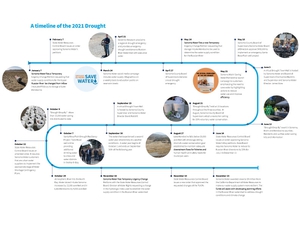Drought Updates
- Visit the U.S. Drought Monitor (USDM) to view current conditions for Sonoma County. These graphics show the location and intensity of the drought.
- Residents are encouraged to continue using water wisely and eliminate water-wasting activities. Learn more water-saving tips at SavingWaterPartnership.org.
- View more information about the Current Water Supply Levels.
Water Conservation
Long-term water conservation by all community members is essential to preserve our water supply in the future.
These are a few water-wasting activities that are prohibited year-round in Sonoma and Marin counties:
- Washing sidewalks, walkways, driveways or other hard-surfaced areas with a hose. Use a broom instead.
- Irrigation runoff to streets and storm drains from overwatering or sprinkler-overspray of landscapes.
- Using a hose without a self-closing shutoff nozzle to wash cars, boats or trailers.
- Irrigating outdoors during and within 48 hours following measurable rainfall.
- Using potable water in decorative water features that do not recirculate the water.
For additional water-saving tips and resources, please visit the Sonoma-Marin Saving Water Partnership website.
Building Resiliency for Future Droughts
- Leveraging better forecasting to increase water storage. A multi-year effort by Sonoma Water, the U.S. Army Corps of Engineers (USACE), Scripps’ Center for Western Weather and Water Extremes and other state and federal partners has increased the effective water storage capacity at Lake Mendocino and Lake Sonoma by managing reservoir levels in the flood pool based on high-resolution weather forecast data and newly developed decision support tools. This innovative program is known as Forecast Informed Reservoir Operations (FIRO). This year, FIRO was also used at Lake Sonoma and provided an additional 30,000 acre-feet of stored water between the two reservoirs. Learn more about FIRO.
- Aquifer Storage and Recovery (ASR) has been successfully applied to improve the resiliency and sustainability of water resources in many other areas throughout the world by allowing stored water to be used in summer months or during droughts. Learn more about the Sonoma Water and City of Sonoma ASR pilot project.
- Groundwater management consists of a variety of programs and projects that aim to sustain and study groundwater resources
- Climate Adaptation Plan guides the review of climate risks to water supply, flood control, wastewater systems infrastructure and operations, and it serves as a roadmap for building, assessing, and putting in place adaptation strategies to make the systems more resilient.
Explore various efforts and initiatives in the timeline below by clicking through the photos and text.

